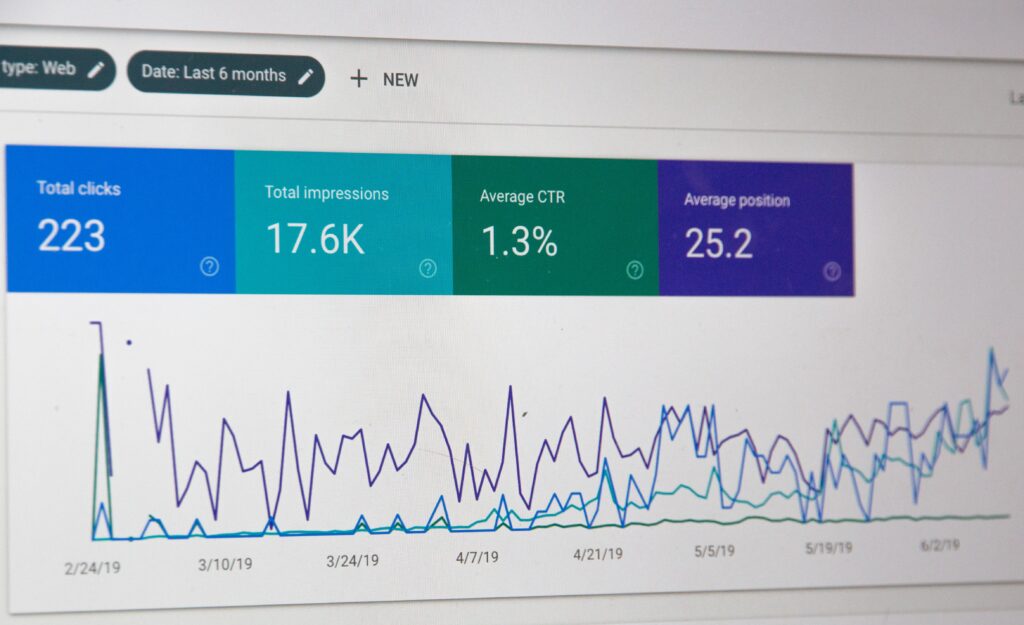Getting Started in Digital Marketing
 Reading Time: 8 minutes
Reading Time: 8 minutes
Digital marketing has become a necessity for small and medium-sized enterprises (SMEs) looking to grow their businesses. It allows businesses to reach their target audience and increase sales through paid ads and other digital channels. However, with so many companies competing for the same audience, it’s important to stay ahead of the competition. In this article, we’ll discuss some of the different ways businesses can promote themselves online and offer some useful insights into how to monitor and analyse your marketing efforts.
Table of Contents
Understanding the Concept of Digital Marketing
Digital marketing is an ever-evolving landscape that can seem overwhelming to many small and medium-sized enterprises (SMEs). At its core, digital marketing involves using various digital channels to promote your business, such as social media, email marketing, and paid advertising. By understanding the basics of digital marketing and what different types of advertising is available, SMEs can create a solid foundation for ensuring that their marketing strategy is successfully implemented. .
The goal of digital marketing is simple: attract, engage, and convert potential customers into loyal customers. With the right tools and strategies, SMEs can do just that. By researching their target audience, they can tailor their messaging to resonate with their customers. This, in turn, can increase the likelihood of conversions and ultimately lead to more sales.
Choosing the right digital marketing channels can also be daunting. With so many options available, it’s important for SMEs to understand where their target audience spends their time online. By focusing on the channels that their customers use the most, SMEs can effectively reach and engage with them.
High-quality content is also a crucial component of any successful digital marketing strategy. By creating informative, entertaining, and relevant content, SMEs can establish themselves as authorities in their industry and increase brand awareness.
Finally, it’s important to regularly analyse and adjust your digital marketing strategy. By tracking your key performance indicators (KPIs), you can identify what’s working and what’s not, and adjust your strategy accordingly. This can help maximise your return on investment (ROI) and keep your business ahead of the competition.
Identifying Your Target Audience
To effectively reach and engage your audience, you need to identify who they are. Understanding your target audience means researching their demographics, interests, and behaviours. By doing so, you can tailor your marketing messages to resonate with them and increase the likelihood of conversions. This step is crucial in making sure you’re not wasting your marketing budget on the wrong people.
Google Analytics and Facebook Insights are two great tools that can help you gather data about your audience. You can use this information to create buyer personas, which are fictional representations of your ideal customers. These personas can help you understand what motivates your audience, what challenges they face, and how you can help solve their problems.

But don’t stop there. You should also engage with your audience to gain insights about their preferences and behaviours. Social media is a great platform for this, as it allows you to interact with your audience and get real-time feedback. By listening to your audience and responding to their needs, you can establish a loyal customer base and gain a competitive edge. Be seen to be an expert in your field and/or offer unrivalled customer service support for example.
Remember, the key to identifying your target audience is to look beyond basic demographics. You need to understand what drives your customers and what their pain points are. By doing so, you can create a marketing strategy that speaks directly to their needs and sets you apart from the competition.
Choosing the Right Digital Marketing Channels
With so many digital marketing channels available, it’s easy to get overwhelmed and confused about where to invest your time and money. But fear not, as we’ve got some tips on how to choose the right channels for your SME.
First and foremost, consider your target audience. Who are they and where do they spend their time online? If your audience is mostly on Instagram, then Instagram ads may be the way to go. If they’re more active on LinkedIn, then LinkedIn ads may be a better option. As mentioned earlier – identifying your target audience is crucial!
Another factor to consider is your budget. Certain channels, such as Google Ads, can be more expensive than others, so make sure you have a clear idea of what you can afford before diving in. Aim to deliver your messages/ads/content etc consistently over time as this will pay dividends further down the line as customers begin to recognise you and your brand awareness increases. Additionally, think about your marketing goals. Are you looking to increase brand awareness, generate leads, or drive sales? Your goals may dictate which channels are the most appropriate for your business.
It’s also important to keep an eye on your competition. See what channels they’re using and how successful they are with them. This can give you a good idea of what’s working in your industry and help you make longer term informed decisions.
Finally, don’t be afraid to experiment. Digital marketing is always changing, and what works today may not work tomorrow. Test out different channels and see what works best for your business. And remember, regular analysis and adjustment of your strategy is key to staying ahead of the competition. Read that again. Regular analysis and adjustment is crucial to any digital strategy!
Crafting a Solid Content Strategy
Content is the backbone of any successful digital marketing strategy, and it’s important for SMEs to create a content strategy that resonates well with their target audience. Start by identifying the topics that matter most to your audience and create content that addresses those topics in an informative and engaging way. This can include blog posts, videos, infographics, social media posts and podcasts for example.
When creating content, always keep your audience in mind. Work backwards from your customers. What are their pain points and how can your content help solve them? What questions do they have that your content can answer? By answering these questions, you can establish yourself as an authority in your industry and build trust with your audience/community.

Another important aspect of content creation is consistency. Make sure you’re regularly producing new content and sharing it across all your digital channels.
This includes areas such as your social media posts, paid ad content (Google Ads & Meta Ads), website copy and marketing emails for example. This will help keep your audience engaged and coming back for more – time and time again.
Finally, make sure your content is optimised for search engines. This involves using relevant keywords, creating meta descriptions, and using headers and subheaders to structure your content. By doing so, you can improve your website’s visibility in search engine results pages and drive more traffic to your site.
Remember, crafting a solid content strategy takes time and effort, but it’s worth it in the long run. By creating high-quality, engaging content that speaks directly to your audience, you can establish your brand as a thought leader in your industry and stay ahead of the competition.
Engaging in Search Engine Optimisation (SEO)
Search engine optimisation (SEO) is a crucial aspect of any digital marketing strategy. It involves improving your website’s visibility in search engine results pages (SERPs) by using relevant keywords, creating high-quality content, and optimising your website’s structure, speed and navigation. By doing so, you can increase organic traffic to your website and improve your overall online presence.
To engage in SEO, start by conducting keyword research. This involves identifying the keywords and phrases that your target audience is searching for online. By incorporating these keywords into your website’s content, you can increase your chances of appearing in search engine results pages.
But SEO is more than just keywords. It also involves creating high-quality content that provides value to your audience. By creating informative, engaging content, over time you can begin to establish yourself as an authority in your industry and increase your website’s visibility in search engines.
Optimising your website’s structure, speed and navigation is another important aspect of SEO. This involves ensuring that your website is easy to navigate, responsive and quick to load and that your content is structured in a logical way. By doing these basic points, you can improve your website users experience and increase the likelihood of visitors staying on your website for longer.
Finally, regularly analysing and adjusting your SEO strategy is crucial for success. By tracking your website’s traffic and engagement metrics, you can identify what’s working and what’s not, and adjust your efforts accordingly. This can help improve your website’s visibility in search engine results pages and ultimately lead to more traffic, leads, and sales. Remember, SEO is an ongoing process that requires time and effort.
Analysing and Adjusting Your Digital Marketing Strategy
Regularly analysing and adjusting your digital marketing strategy is crucial for SMEs looking to stay ahead of the competition. This involves tracking your key performance indicators (KPIs) and making changes based on the data. By doing so, you can identify what’s working and what’s not, and adjust your strategy accordingly.
Start by identifying your KPIs. These may include website traffic, conversion rates, click-through rates, and social media engagement. By tracking these metrics, you can gain insights into how your digital marketing strategy is performing.
Regular analysis of your KPIs can help you identify trends and patterns in your data. For example, if you notice that your website traffic is decreasing, it may be time to re-evaluate your SEO strategy or adjust your paid advertising campaigns. Similarly, if you see a high click-through rate on a particular social media post, you may want to create more content that resonates with your audience in a similar way.
Remember, analysing your digital marketing data is just the first step. You also need to make changes based on your findings. This may involve tweaking your ad targeting, adjusting your content strategy, or investing more in a particular digital channel.
Regular adjustment of your digital marketing strategy is key to staying ahead of the competition. By testing out new strategies and making changes based on your data, you can continuously improve your marketing efforts and achieve better results. So don’t be afraid to experiment and try new things – you may be surprised at the positive impact it can have on your business.
In conclusion, digital marketing should play an integral role in your within your business and over time, a well planned and organised strategy that is constantly delivered to your target audience will result in a growth. However, consistency and regular monitoring of digital channels is required to ensure that you are getting an ongoing ROI from your advertising.



